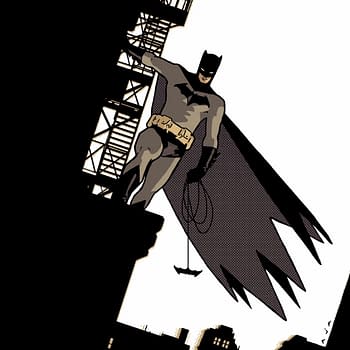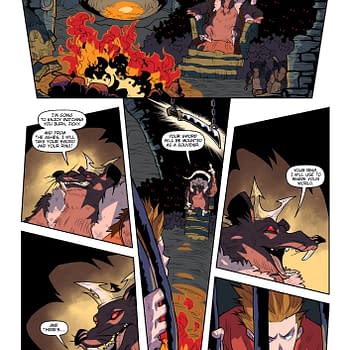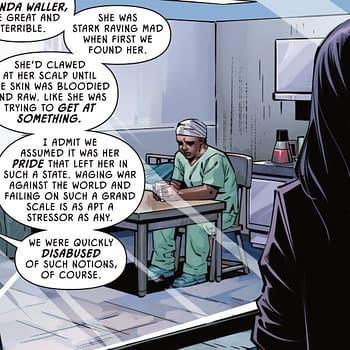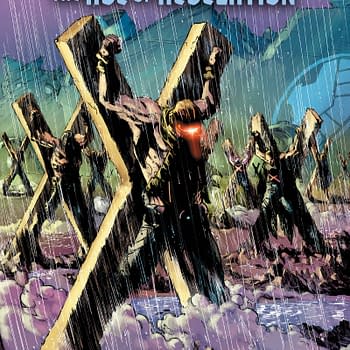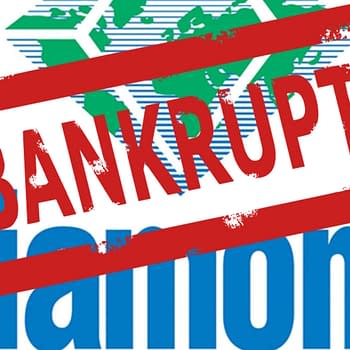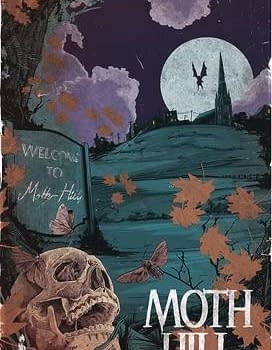Posted in: Comics | Tagged:
When Phil Jimenez Put A Nipple Ring On The Cover Of Teen Titans – 30 Years Of Gays In Comics At San Diego Comic-Con
Dane Styler wrote from San Diego Comic-Con for Bleeding Cool,
On the Saturday night of last month's San Diego Comic Con, Gays in Comics, the longest-running comic book panel in history, celebrated its 30th anniversary of advocating diversity and spotlighting the creators, comics, and fans of the LGBTQ community. It was also announced that next year the panel will change its name to Out in Comics, so as to be inclusive of everyone who identifies on the queer spectrum.
Founding moderator and author Andy Mangels (Wonder Woman '77 Meets the Bionic Woman) chaired the panel and welcomed Sina Grace (Iceman, Self-Obsessed, Burn the Orphanage), Tara Madison Avery (Anything That Loves, Gooch, Alphabet), Phil Jimenez (Superwoman, Wonder Woman, Infinite Crisis), Molly Ostertag (Shattered Warrior, Strong Female Protagonist, The Witch Boy), and Steve Orlando (Midnighter and Apollo, Supergirl, Justice League of America).

After a discussion and a subsequent Q&A, the event closed with a Prism Award presentation, and the Prism Comics Fan Mixer.
The following are abridged highlights from that discussion.
DISCLAIMER: Some subjects discussed are of a mature theme, and may not be suitable for those younger than 18 years. Then again, maybe this is exactly what teenagers need to be reading.
ANDY: What does the phrase "gays in comics" mean to you?
TARA: I think of Gays in Comics as always the flagship panel of queer popular culture. It was always a highlight of my con, for a quite a long time. It was a place where you… you were a fan all year, you were a creator all year, but you didn't see your people until you came to Gays in Comics. That was always special to me.
MOLLY: I really think I'm the beneficiary of this history you guys have built. I have been in comics professionally since I graduated from school three years ago, so my world of comics is incredibly weird. The community [online], it's almost the norm to be queer in some way. I think it's really exciting, and especially because it wasn't like that when I was kid growing up. It's incredible in my twenties to discover this community. So thank you for all the work you've done to make comics super gay.
STEVE: I tend to think about the progress […] It's about the types of stories we can now tell. We went from something like Midnighter and Apollo where we had a twelve issue build up to them kissing, because we didn't want to push it too far, too fast. Flash forward to when I started working in comics, and we have bottoming in the first issue.
It is impressive what is coming into the conversation, and it's because of the growing community – not just here but in different panels – but also as we come into our own, asking questions of what we can do, and pushing our voice forward.
ANDY: Comics appear in so many formats these days, including webcomics, and everything we as creators are producing have the ability to go multi-media. What does that format change mean to the political progress we've made? Which came first?
STEVE: There is more access to use your own voice and to create comics than ever before. As those things disperse, as you see that diaspora of ideas… you asked what comes first, is it the stories or does the political change drive it, and I think the stories are what come first.
To be quite blunt, for those who have a history of not being okay with our community, the progress of those people starting to see other people as human begins with getting to know them, to give them a face to see, to not see them as alien, and you can do that through stories. And I think that drives the political gains. That's the importance of representation. It's not a gimmick. It's the way we show people we are human.
MOLLY: Webcomics in particular are so queer because I think it's people who never saw themselves represented. What I love about comics is that they are a visual medium that you can create easily, and thanks to the popularity of webcomics, you can also share them easily with people who will get really excited about them, and you don't have to go through any gatekeepers.
What is exciting to me is to see this hunger for these queer stories start to get mainstream recognition. There is a really voracious readership there that just wants to consume, and wants to throw money at stories, because we've never seen anything like that in mainstream media.
I optioned The Witch Boy for film, for which I'm excited and really hope it goes forward. It's a really quiet and queer story about gender non-conformity, and I thought no one would want to make this into a film. But I think we have made it in the counter-culture, and now these big companies are trying to figure out how to do it and they are coming to us, and I love it.
PHIL: The characters that I always gravitated to have, I believe, a queer sensibility, if not queer in metaphor as well. But now I'm working on a project for Warner Brothers, it's about my father's family and has tons of LGBTQ content. And I have to say, Warner Brothers have been extraordinary and I'm shocked. They keep asking more, more, more. I think it's because one, they sense an audience for it, and two, because they all seem personally interested in it.
One of the discussions I've been having with a scholar friend of mine is about when representation is supposed to be queer but they get it wrong. And it's easy to get it wrong, because it is such a specific journey, and if the details don't quite match up, there could be greater resistance to it.
MOLLY: I agree. I think, especially as a gay woman, who is kind of androgynous, the amount of material out there that says it's lesbian… but it's not.
ANDY: There has been a lot of discussion lately of creators writing LGBTQ characters even though that journey might not be their own experience, and so they might get some of the details wrong. And the LGBTQ community responds strongly to that. How do you feel about 'getting it right,' and how do we, as creators, help in that regard?
TARA: Getting it right means different things in different segments of the comics world. Superheroes kind of do the same stuff whether they are gay, lesbian, bisexual, asexual, or other. They fight the bad guys. They wear dashing costumes. And the subplots are where these identities tend to manifest.
But if you're doing something that is outside these commercial genres, if you're doing something autobiographical, something more focused on literary folks, you have more freedom to explore things that distinguish certain gender identities or orientations. There's more time for this stuff in books where you don't have to save the world from Galactus. As such, I think these comics have the advantage when it comes to representation.
SINA: For a really long time, I never thought, oh, I'll only work with a gay character. I was just like, I'll work with the sandbox and be happy to. And it took a long time, and it took listening to Kelly Sue DeConnick talk on these panel, to be like, oh, maybe it's because I never thought I was allowed. And I think what is going on with the community is that we are all realizing we're allowed to start asking for things. And it's so fresh, and as creators it's new to think, "I can be me. I can speak to my interests on paper."
There is this mass – we are all like shaping and forming and coalescing and understanding this thing together. And that's why there is this back and forth. We're trying to get it right. We're trying to listen to these bureaucracies and these companies telling us what they think is right. And we're trying to do what our stomachs are telling us what is true. And we're trying to listen to all these people who have needs and wants from the reading experience.
We're all just sorting it out and there's going to be a bit give and take, and some mistakes along the way. At the end of the day, I think any project that lasts, that is worth people's time, is usually the one that you can tell the creators are really trying. It's not a PR stunt.
ANDY: How do you deal with the sex part of bisexuality and homosexuality?
STEVE: When we were developing Midnighter and Apollo, the decision from the outset that Midnighter was an adult and sexually active male. Honestly, there was very little opposition, there was a lot of support, and it helps that our editorial team was also queer. And a lot of the people around the book were too.
I told them, when it came to the sex in Midnighter, anything you could see Dick Grayson or Green Arrow do with a woman, you could see Midnighter do with a man. And that was the standard. It was keeping to the standard you have with a straight couple, which is what I thought we deserve.
ANDY: Molly, have you had any sex characters or sex issues in your books?
MOLLY: Not really. I think it's a little different for queer women. This is sort of a very gay guy question.
ANDY: Are you saying lesbians don't have sex?
MOLLY: No. I mean that I think that progressive and sex-positive people are not as into sexualizing women, which I'm a fan of, but are much more comfortable with sexualizing men and exploring sex between men in this really fun way. They could maybe get kinky or crazy or fun, and I don't think we're quite there with women yet. I would love for it to be but like I alluded to earlier, the fear of it taking over is a specter that hangs over the heads of a lot of artists.
TARA: There's another topic for emerging identities. Having sex while trans is a big topic for a lot of people because you never know where a person is in their transition or what their transition constitutes.
That's a topic I'm trying to allude to without being too terribly explicit, and it's also some of the stories we're going to be including in our upcoming book about trans called We're Still Here, an anthology and the first of its kind. We have to tell people how it's different for us, and how it's still awesome.
ANDY: Phil, you drew the first nipple ring on the cover of a comic – Teen Titans.
PHIL: One quick thought. I tend to avoid drawing sex scenes, mostly because I do superhero comics, but also because I realized as an artist, I'm not sure I have much of a point of view about, say gay pride art. I found myself just referencing a lot of images, and it wasn't at all interesting.
So I've often struggled with queer erotic art, as I get so many people over the years asking me when am I going to do gay comics art, specifically erotic comics, and I'm trying to figure out what that would look like. The problem is it would just end up looking like referenced porn. A lot of the stuff I'm actually attracted to is not highly referenced. It tends to be stylized or abstract, or even cartoon.
ANDY: Sina, you have Iceman using dating apps and trying to get laid in Marvel Comics.
SINA: Well I'm super lucky, and also super stressed at all times because you have some people who really want this guy to bam bam […], and then you have other people saying he's not gay, what did you do? I'm like, I didn't do shit. I got a job is what I did.
I'm just leaning into all of it. He's figuring this all out, so I'm just using that to keep the conservative people at bay and let them read this and not feel confronted with stuff they're not comfortable with, while honoring this character's journey.
I'm being true to the character as he's just sorting this all out and getting his feet wet, and I'm using that to just take my time. And it's cool too because then it also creates great superhero stories. It's a first for everything. This guy Bobby Drake who has been so confidant and so powerful for so long, I get to bring him back to Spider-Man, year one insecurity, and have him be fumbling every step of the way.
ANDY: In Star Wars: Rogue One, how many people realized that the blind Asian man and his partner were actually lovers? It was so coded, that you really had to get it and read into it. It's playing it safe. We have what appears to be a media in which it's acceptable to do things, but do you find yourself still coding things or still concerned about what you actually show?
MOLLY: As one who makes comics online, and I don't work with the big two or do monthlies at all, I'm interested in graphic novels, I find that I'm completely unconcerned with what straight people think. My only concern is affecting people who are LGBTQ. I've never felt the need to code a character.
TARA: For me when it comes to pleasing the company, I only need to please me. I imagine the only straight people who read the comics that I publish are the parents of people who buy them or make them. It's one of those things that depends on which segment of the comics world that you're in.
PHIL: I also find, personally and historically for me, the biggest pushback to the content-creator discussion is from other gay men, primarily, who become particularly aware of representation in the media, and how other people perceive these characters. And so it's layers of perception.
There's a trend at least in superhero comic books where if you introduce two gay male characters, together, and they would quickly marry them off. Neuter them, essentially. And we were all happy because it seemed progressive, on some level, because it's a huge deal to see two gay characters married in a comic book.
But at the same time it was rarely through the long lens of dating, sex, etc. And by stripping them of their sexual power, it sort of made them acceptable, not just to the companies but also to gay male readers who themselves did not want to be seen as overtly sexual.
STEVE: Something with the big companies, you cede some of the ownership obviously and control in exchange for the platform. At least for now, that's just the reality. If you want to use the platform of Justice League or Batman, to reach a wide audience, there are rules that apply. It's a give and take to please the people who make your book a reality.
MOLLY: As there is more of us, creating more gay characters, you can have so many characters so there's not one carrying the burden of representation.
STEVE: It's a diversity of diversity. There was this question asked, "How do you shoulder the responsibility of making Midnighter appeal to every gay person born ever?" And the answer is exactly what we are you saying – you can't. The only responsibility is to depict three-dimensional, fully rendered, fully layered, humanistic characters with all the faults that come with that, and then our responsibility is to do it again, and again, and again.









